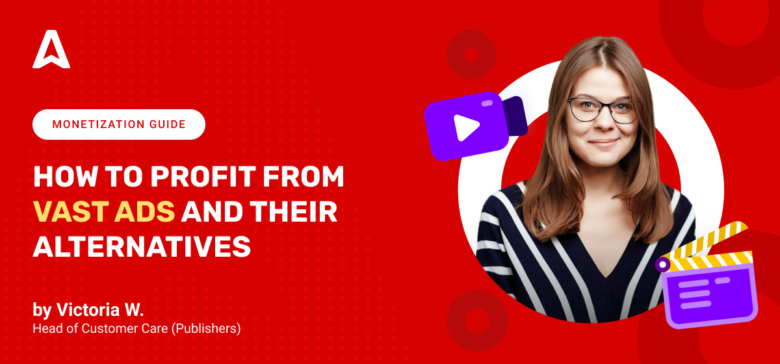VAST ads are known for their profitability for publishers. But with many technical tricks behind the whole process, it may be challenging to install scripts. Adsterra experts race to the rescue! Our Head of Customer Care (Publishers), Victoria, is here to walk you through video monetization basics and reveal the nearest VAST alternative with high payouts.
VAST ads alternative to try right now
With many difficulties related to VAST codes, publishers avoid video monetization. Indeed, there are some VAST disadvantages you can’t ignore (and we’ll talk abiut the later). But why refusing of the video format? Publishers still can profit from multimedia ads without even having a video player on their website! How exactly? By putting Social Bar on web pages. Let’s make this topic a bit more clear right now.
What are alternatives to VAST?
When we say “VAST ads alternatives”, we don’t exactly mean the same video content. In case of Adsterra Social Bar, for example, you get various types of dynamic content. This can be animated widgets, short videos, interactive quizzes, surveys, etc. The main advantage is that these ads are easy to place, and they don’t require extra efforts. But anyway, these are NOT classic VAST videos. So how to get Social Bar?
How to get Social Bar codes (incl. video)
- If you’re new to Adsterra, please sign up as a publisher. If you’re already with us, then log in first.
- Find the Websites tab (you can find it on the vertical toolbar). Click ADD WEBSITE if you want to add a new domain. If you need to get the code for an already added website, choose it from the list and hit ADD CODE.
- In the pop-up window, you need to fill out the available fields. Pick Social Bar from the Available Ad Unit list.
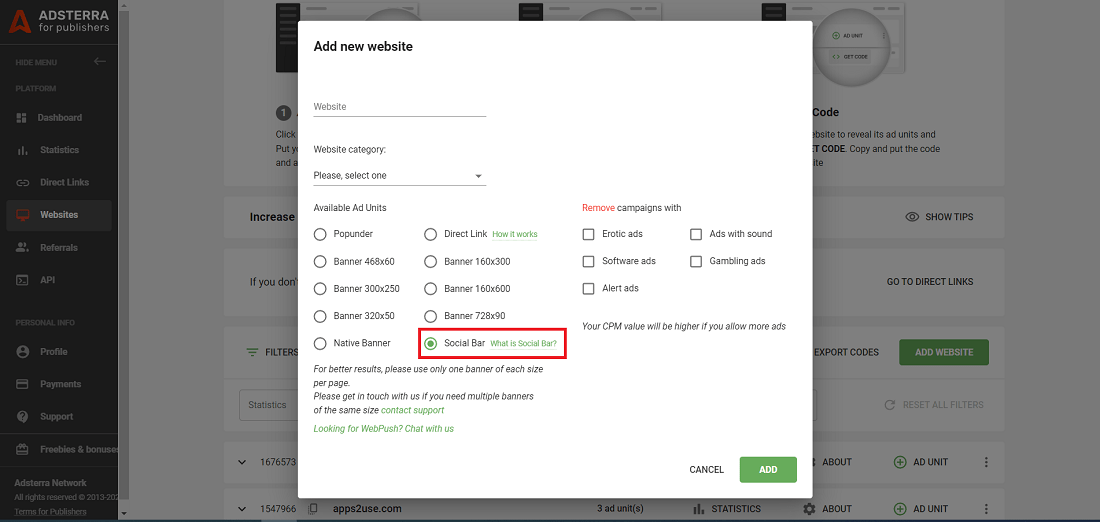
You can get the ad code after Adsterra approves your request. There are two ways to check if it is OK.
#1 way. From your Publisher’s account, open the Websites tab. Find the website you requested the code for. Click the down arrow icon and then, click GET CODE.

If you see the Pending website’s status, please, wait until it is approved.
On the pop-up window, please copy the code and read the short instruction on where to place it. You can now switch to your website and paste the code!
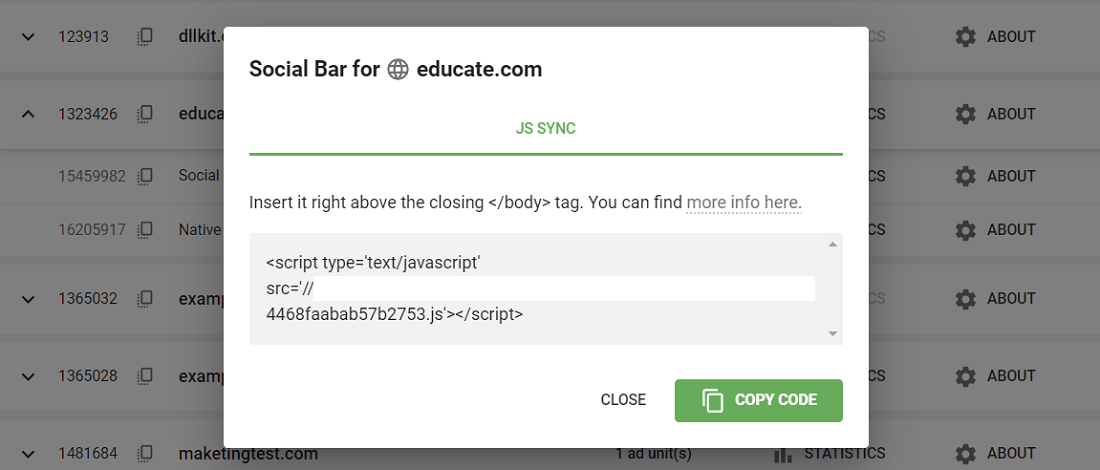
#2 way. You can get the Social Bar code from the confirmation email we send you after the approval. On the inbox, open the email from the Adsterra Team (you might need to look in the spam box if you can’t find it).
Open the letter and click the View Code Scripts button.
From the email, follow to the scripts page. Please copy the code as is without making any changes. You will need to paste according to instructions you got earlier.
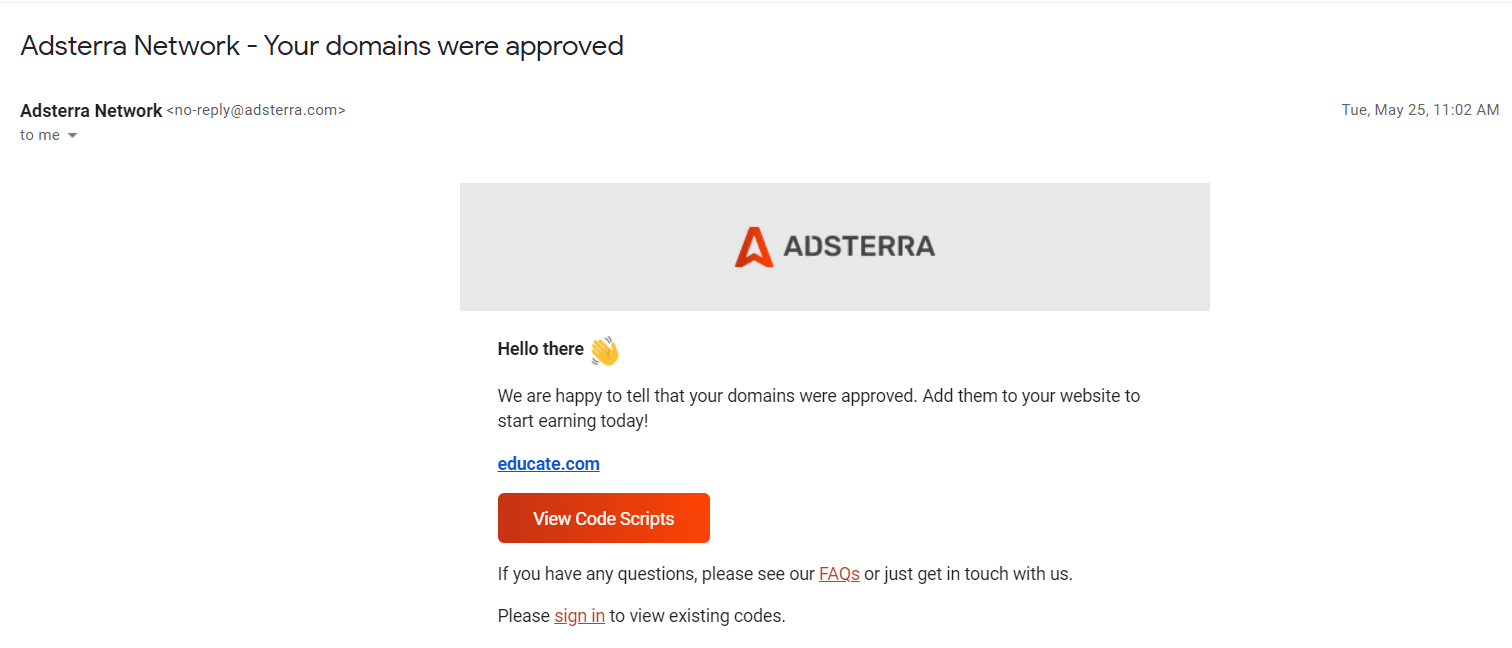
Now that we’ve done with alternative advertising formats, let’s focus on VAST ads themselves. We will now walk you through which VAST ads types exist, how they are used, and what you need to prepare before start making money with this format.
VAST ads explained
Each ad network has its own format of the advertising JS code or iFrame tag. Browsers recognize and execute these tags easily.
Unlike static ads, video ads are embedded in the video players. Here we have the standard of the ad code that tells a video player which ad to show at a particular moment.
VAST/VPAID has become this standard. VAST or Video Ad Serving Template is an XML file. It contains data about an ad that a publisher’s video player should execute at the moment.
What are VAST tags used for?
Publishers add VAST tags to their video players and make money on showing advertising offers before, between, or after the main content. Just like Popunder ad codes, VAST video tags help publishers monetize their video content and websites in general. Advertisers track their ads’ efficiency (CTR, clicks, volume of impressions) and select those publishers whose traffic they are willing to pay for.
Ways of serving VAST ads on a publisher’s website
All publishers are interested in showcasing ads to a broader audience and get as many paid impressions as possible.
Let’s list the ways of serving video ads and look at their advantages and disadvantages.
1. In-stream advertising
These high-quality video ads are played on top of the player’s content (like online cinemas). All content is in the viewer’s eyesight. These types of ads are accurately targeted. Advertisers usually pay higher for them.
The key point is that these ads come along with the content a user intends to watch. So, they engage users incomparably better than those out-stream types.
2. Out-stream advertising
Usually, these ads cost less. They’re placed inside video players that don’t have any content. You may have seen them on news websites, on the sidebar parts of the pages. Out-stream videos are still in demand, however, not all publishers are ready to place them as they’re pretty pushy.
3. Pre-roll video ads
It’s a preferable mode of playing video ads for both advertisers and publishers. The promotional videos are placed before the main content of the player. Though there are opposite opinions, we recommend this mode as the primary.
Users are eager to watch the video you offer. So, it’s OK if you show an ad before the video they are so motivated to watch.
4. Mid-roll video ads
As it comes from the name, mid-roll ads appear between the pieces of content you expose to your users. Some would claim that a mid-roll method of playing ads is more engaging because users are halfway to getting the content they need so much. But it isn’t enjoyable either. If you slice your content with several mid-roll ads, users may simply leave.
So, it’s about your audience. Please think of how it consumes videos and how to make them react to ads.
5. Post-roll video ads
Showing ads in a post-roll mode, it’s not a go-to idea, because in this case, users will get the promoted video only AFTER they watch the main content. It can make sense if you’re streaming educational videos, and after each lesson, users can get a bonus handout or a discount from you.
What you need to know before you start making money with video ads
1. Make sure your website is ready to serve video content
Well, that’s health check you will have to carry out. Although the majority of websites support video content, some hidden tricks may be awaiting you.
Fast hosting provider is a must for VAST
When a website runs on shared hosting, it literally shares the server’s capacities with multiple other websites. Just to ensure you’re all ready, give this guide to publishers’ web hosting services a read.
Will you always need to embed a player? No, if you’re dealing with Social Bar ads, for instance. You can paste them as a simple JS code without adding any extra elements to your website.
Your WordPress (or other CMS) version
If you run a WordPress-based website, you will need to choose a credible video player plugin that supports ad tags. It’s mega important to check if your player is compatible with your WP version. It is fair for all CMS and website-building platforms.
Later on, we will give a brief guide on enabling ads for the Fluid Player. However, you can select the one that suits you best.
Your website builder’s limitations
If you have built a website using a free website builder, make sure your license allows you to stream video content. Some website builders restrict the volume of data your visitors can view within a month. It is called “bandwidth limits.” For instance, the free version of the Wix builder limits you to 500MB of data.
2. Subscribe to a high-quality video player
To monetize a website with VAST video ads, you need to install a video player first. It is better when it is a powerful tool with multiple settings so that you could adjust them to your needs.
In most cases, you will have to pay for a subscription, but it’s worth it.
Here are some of the video players that publishers and website owners mostly use to monetize VAST video ads:
- JW Player
- Brightcove
- Brid.TV
- Video.js
- Fluid Player
- FV Player VAST
- and many others
How to add VAST codes to a video player
Now let’s see how you can put VAST ads on a video player and start making great money. Unlike any other ad formats, this one is only compatible with a video player.
You can get all these instructions from your video player provider, as well. Always check with them because some settings can be updated. And one more thing: we list here the most common ways of embedding VAST ads, but if your ad network provides you with alternative instructions, please follow them instead of those given below.
Instructions on placing VAST codes to video players
90 percent of all settings you will have to make in your video player. Please, read the instructions provided by your video player and make sure you have the updated data as digital products can upgrade pretty fast.
Adding VAST ads to Brightcove
Brightcove provides a CMS where you can place the VAST code in the Advertising section.
👁️🗨️The full article is available in Brightcove’s documentation.
Now we will examine one of the steps — enabling advertising.
- Login to Brightcove Studio and open the PLAYERS module. You need to create a new player or choose a player you want to add the VAST code to.
- Hit Advertising from the navigation menu.
- Check the Enable Client-Side (IMA).
- For the Ad Tag, paste the Adsterra VAST code you got earlier.
- Leave other values as is.
- Click Save.
- To publish the player, click Publish & Embed > Publish Changes.
Before you save all settings, check the Advertising section. It should look like this:
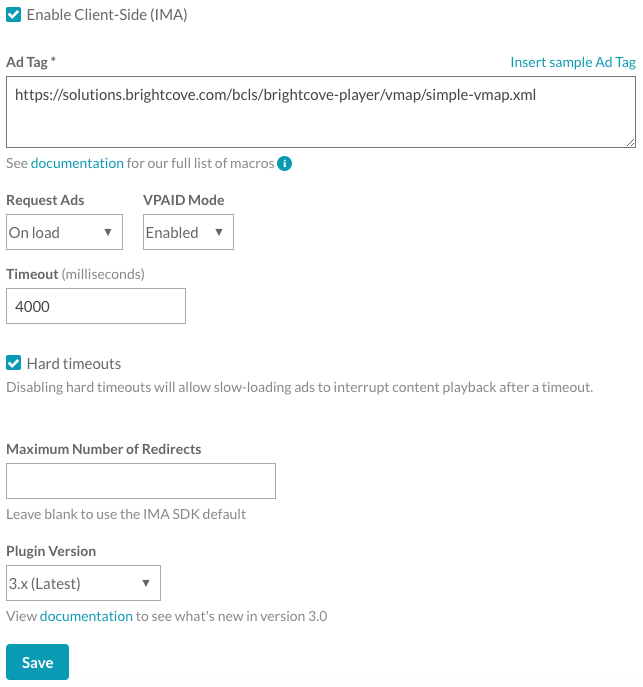
Adding VAST ads to BRID.TV
With BRID.TV CMS, you can easily add VAST codes to the video player. Follow these steps:
- From your account, find the PLAYERS section in Brid.
- Pick any of your players.
- Scroll down till the MONETIZATION dropdown. Make sure that the monetizable checkbox is checked.
- Click on the ADD PRE-ROLL button.
- Paste the VAST code in the Desktop-only Ad Tags and make sure it is valid (watch the preview).
- Click SAVE.
👁️🗨️ Read the full tutorial.
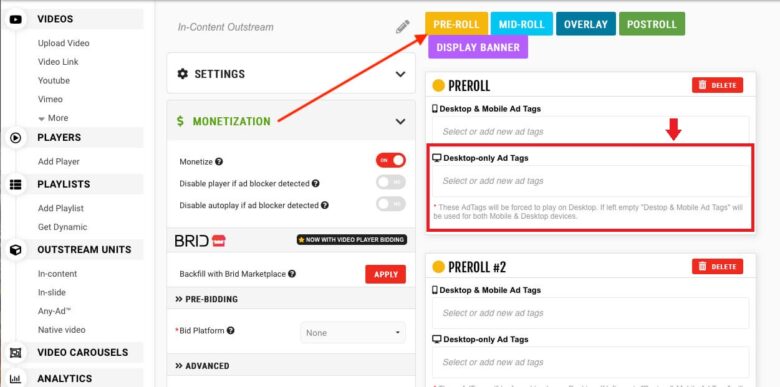
Adding VAST ads to JW Player
As it comes from the JW Player’s documentation, you can run video ads only if your subscription plans are Business or Enterprise.
Adding VAST video codes to JW Player consists of two main stages: adding an ad schedule and enabling advertisement.
👁️🗨️ Adding Ad Schedule (official tutorial).
👁️🗨️ Enabling advertising (official tutorial).
Step 1. Create an Ad Schedule
- Click Ad Schedules > Create Ad Schedule. The Ad Schedule screen will appear.
- Enter a name for the ad schedule.
- In the Select Your Ad Manager section, tick VAST.
- In the Configure Ad Breaks section, click the + icon to create a Preroll, Midroll, or Postroll ad break.
- In the text box, enter the VAST code if there are no other instructions from your ad network.
- Click SAVE.
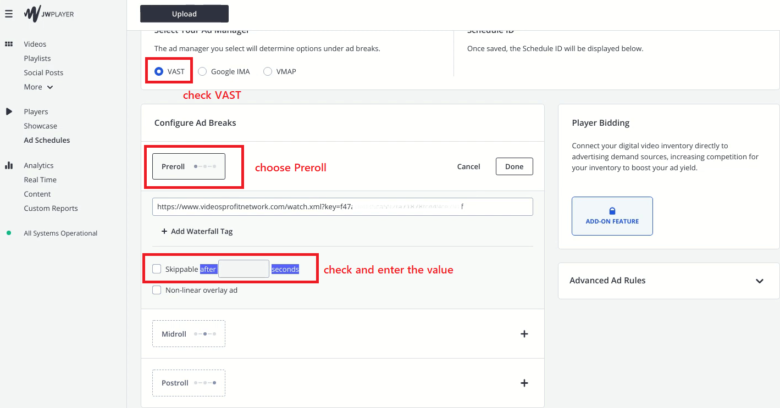
Step 2. Enable advertising for your player
- Navigate to Players.
- Click on the player you need and open Advertising.
- Set the Advertising toggle ON and select the VAST schedule you created on Step 1.
- Click Save.
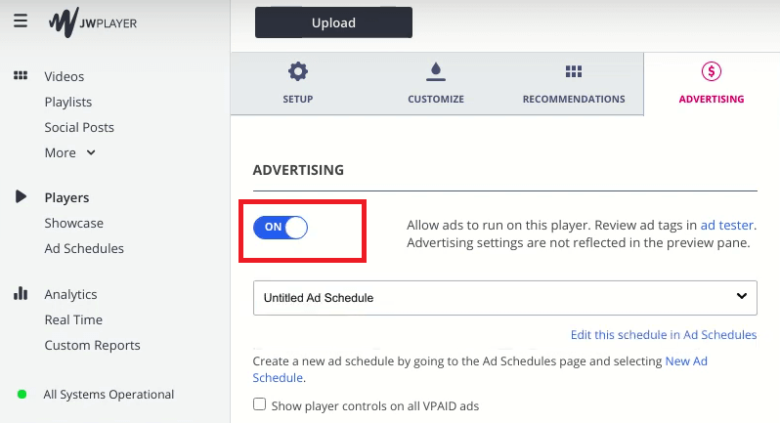
Adding VAST ads to Video.js player
Video.js player requires the videojs-vast-plugin available. You can take it from this Github repository.
The plugin reads a VAST file, takes the first video it can, and plays it as a pre-roll ad before your main video content. It will also redirect users to the URL the advertiser places.
You will need to add the Javascript files and CSS. Please copy all of the following pieces of code from the official Video.JS repo on Github. In this post, we can only navigate you to the right destination.
You need to add the supporting Javascript files and CSS.
<link href="videojs.vast.css" rel="stylesheet" type="text/css">
<script src="vast-client.js"></script>
<script src="video.ads.js"></script>
<script src="videojs.vast.js"></script>
Then, in your player configuration, specify where your VAST file is:
plugins: {
ads: {},
vast: {
url: 'https://www.videosprofitnetwork.com/watch.xml?key=your_unique_key'
}
} EXTRA: How to put VAST ads on a WordPress website
1. Install a video player on a WordPress website
Let’s take a look at one of the widely used, the Fluid Player plugin.
- From your Admin panel, navigate to Plugins and click Add New. Type in “fluid player” in the search field. Once you find it click Install now. Then, activate the plugin. You can also upload the plugin files to the /wp-content/plugins/fluid-player directory, but it is safer to use the WP interface.
The next step is to add a player to a WordPress page or the whole website. We will see how to place Fluid Player on a separate blog post/page.
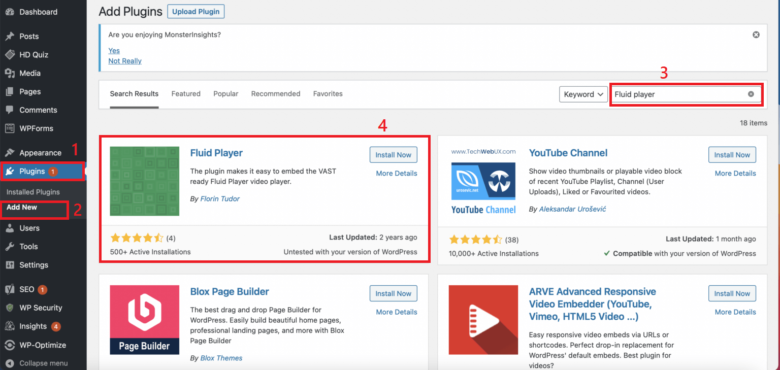
2. Embed VAST ads on the WordPress page
Now you need to create a new WordPress post or page.
- From your Admin panel, click Posts (or Pages) > Add new. The new blank page will open. It is enough for our test. Click on the ➕ icon (Add block) and scroll down to pick the Custom HTML block.
- Then, simply paste this piece of code. You will need to replace the text parts with the link to your video and your VAST code.
[fluid-player video="insert your link to video here" vast_file="insert your VAST code here"]
Here is where you can pick the Custom HTML block to paste the VAST tag.

Advantages of video ads
Now that we have come a long way of “how-tos,” it’s time to talk about profits. Eventually, that’s why you integrate video ads into your video content 🙂 So, how beneficial is serving video advertising on a publisher’s website?
1. Publishers get access to multiple advertisers
Video content is truly versatile, and you can be sure to attract the most prominent verticals whose content is better to expose in video format. Like which, for example?
- iGaming
- VoD (Video-on-demand)
- Sports
- Games
- Dating
- E-commerce
- Movies, TV series, and Music
2. Big advertisers that are ready to pay much
As you can see from the list above, all advertisers that prefer video ads are always on top. Despite the pandemic punch, they survived and grew their online marketing even more robust.
Video content usually comes at a price. Marketers are ready to bid higher for promoting it. And when they notice a lovely CTR on a publisher’s website, they whitelist this traffic source and increase their payouts.
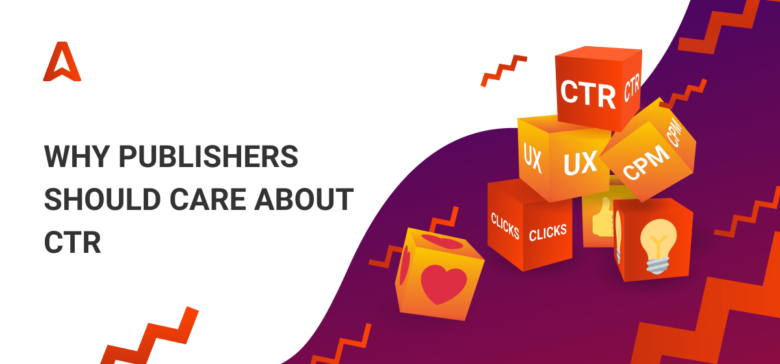
Not only CPM! Some metrics affect a publisher’s income even stronger. CTR is among them. Read how you can improve your website’s CTRs and get paid higher!
3. High engagement
Pre-roll videos catch the pre-warmed users just before they start watching the initial content. Mid-roll videos don’t let users look at the other side while they’re waiting for the next piece of the main content to start.
And, as we have found out earlier, high engagement equals higher CTRs and multiple clicks.
4. The booming demand among advertisers and consumers
The more verticals go online, the more multimedia ads they will produce. This is also fair for content consumers.
As of Statista, the share of digital video penetration is about 85% in the US.
The video ad market is proliferating. The number of businesses that will use video in their marketing has reached 86%. Also, from the WiseOwl Survey: 85% of users would like to see more videos from brands.
5. Impressive CPM rates for video ads
The only conclusion we can make from all the points above is that the cost of video ads will remain very pleasing for publishers. And paired with the ever-growing demand, they can make you some really nice cash.
Though most marketers will invest in YouTube, web publishers who stream helpful videos on their inventory can monetize their websites impressively with video ads. That’s mainly because of the restrictions on some types of ads (like online casinos) or GEO specifications.
Disadvantages of video ads
- VAST ad codes are not as demanding to your hosting as video format itself. Multimedia can seriously harm your website speed if we’re not talking about Social Bar.
- Video advertisements are pretty hard to create, so you won’t get millions of advertisers.
- You will need some tech skills in setting up a video player if dealing with VAST format. With Social Bar, however, you will only need to paste one line of code on your web page.
- If you don’t have enough engaging video content, it’s better to choose alternatives to VAST. You simply won’t attract enough ad views.
Summary
If you’re determined to monetize your website traffic with VAST ads or Social Bar, you’re on the right track. Marketers will be creating more and more multimedia content.
With Adsterra, you can enable video ad codes that don’t require neither a powerful hosting, nor a video player. Our Social Bar is a set of high-converting ad types that include short videos and animations. But if you still want to monetize VAST, go ahead — it’s a truly beneficial format.
And, finally, make sure you know about all your monetization opportunities. Read our guides to Popunder ads or Native Banners and grow your earnings!
